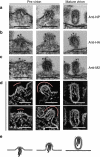Three-dimensional analysis of ribonucleoprotein complexes in influenza A virus
- PMID: 22273677
- PMCID: PMC3272569
- DOI: 10.1038/ncomms1647
Three-dimensional analysis of ribonucleoprotein complexes in influenza A virus
Abstract
The influenza A virus genome consists of eight single-stranded negative-sense RNA (vRNA) segments. Although genome segmentation provides advantages such as genetic reassortment, which contributes to the emergence of novel strains with pandemic potential, it complicates the genome packaging of progeny virions. Here we elucidate, using electron tomography, the three-dimensional structure of ribonucleoprotein complexes (RNPs) within progeny virions. Each virion is packed with eight well-organized RNPs that possess rod-like structures of different lengths. Multiple interactions are found among the RNPs. The position of the eight RNPs is not consistent among virions, but a pattern suggests the existence of a specific mechanism for assembly of these RNPs. Analyses of budding progeny virions suggest two independent roles for the viral spike proteins: RNP association on the plasma membrane and the subsequent formation of the virion shell. Our data provide further insights into the mechanisms responsible for segmented-genome packaging into virions.
Figures




Similar articles
-
Structure and assembly of the influenza A virus ribonucleoprotein complex.FEBS Lett. 2013 Apr 17;587(8):1206-14. doi: 10.1016/j.febslet.2013.02.048. Epub 2013 Mar 13. FEBS Lett. 2013. PMID: 23499938 Review.
-
Importance of the 1+7 configuration of ribonucleoprotein complexes for influenza A virus genome packaging.Nat Commun. 2018 Jan 4;9(1):54. doi: 10.1038/s41467-017-02517-w. Nat Commun. 2018. PMID: 29302061 Free PMC article.
-
Architecture of ribonucleoprotein complexes in influenza A virus particles.Nature. 2006 Jan 26;439(7075):490-2. doi: 10.1038/nature04378. Nature. 2006. PMID: 16437116
-
Complete and Incomplete Genome Packaging of Influenza A and B Viruses.mBio. 2016 Sep 6;7(5):e01248-16. doi: 10.1128/mBio.01248-16. mBio. 2016. PMID: 27601575 Free PMC article.
-
Structure of influenza virus ribonucleoprotein complexes and their packaging into virions.Rev Med Virol. 2010 Nov;20(6):380-91. doi: 10.1002/rmv.666. Rev Med Virol. 2010. PMID: 20853340 Free PMC article. Review.
Cited by
-
Incomplete bunyavirus particles can cooperatively support virus infection and spread.PLoS Biol. 2022 Nov 15;20(11):e3001870. doi: 10.1371/journal.pbio.3001870. eCollection 2022 Nov. PLoS Biol. 2022. PMID: 36378688 Free PMC article.
-
Antisense Oligonucleotides Targeting Influenza A Segment 8 Genomic RNA Inhibit Viral Replication.Nucleic Acid Ther. 2016 Oct;26(5):277-285. doi: 10.1089/nat.2016.0619. Epub 2016 Jul 27. Nucleic Acid Ther. 2016. PMID: 27463680 Free PMC article.
-
The influenza A virus PB2, PA, NP, and M segments play a pivotal role during genome packaging.J Virol. 2012 Jul;86(13):7043-51. doi: 10.1128/JVI.00662-12. Epub 2012 Apr 24. J Virol. 2012. PMID: 22532680 Free PMC article.
-
One influenza virus particle packages eight unique viral RNAs as shown by FISH analysis.Proc Natl Acad Sci U S A. 2012 Jun 5;109(23):9101-6. doi: 10.1073/pnas.1206069109. Epub 2012 Apr 30. Proc Natl Acad Sci U S A. 2012. PMID: 22547828 Free PMC article.
-
Influenza A Virus Defective Viral Genomes Are Inefficiently Packaged into Virions Relative to Wild-Type Genomic RNAs.mBio. 2021 Dec 21;12(6):e0295921. doi: 10.1128/mBio.02959-21. Epub 2021 Nov 23. mBio. 2021. PMID: 34809454 Free PMC article.
References
-
- Palese P in Fields Virology (eds Knipe, D. M. & Howley, P. M.) 1647–1689 (Lippincott, Williams & Wilkins, Philadelphia, 2007).
-
- Jennings P. A., Finch J. T., Winter G. & Robertson J. S. Does the higher order structure of the influenza virus ribonucleoprotein guide sequence rearrangements in influenza viral RNA? Cell 34, 619–627 (1983). - PubMed
-
- Pons M. W., Schulze I. T., Hirst G. K. & Hauser R. Isolation and characterization of the ribonucleoprotein oh influenza virus. Virology. 39, 250–259 (1969). - PubMed
Publication types
MeSH terms
Substances
LinkOut - more resources
Full Text Sources
Other Literature Sources

